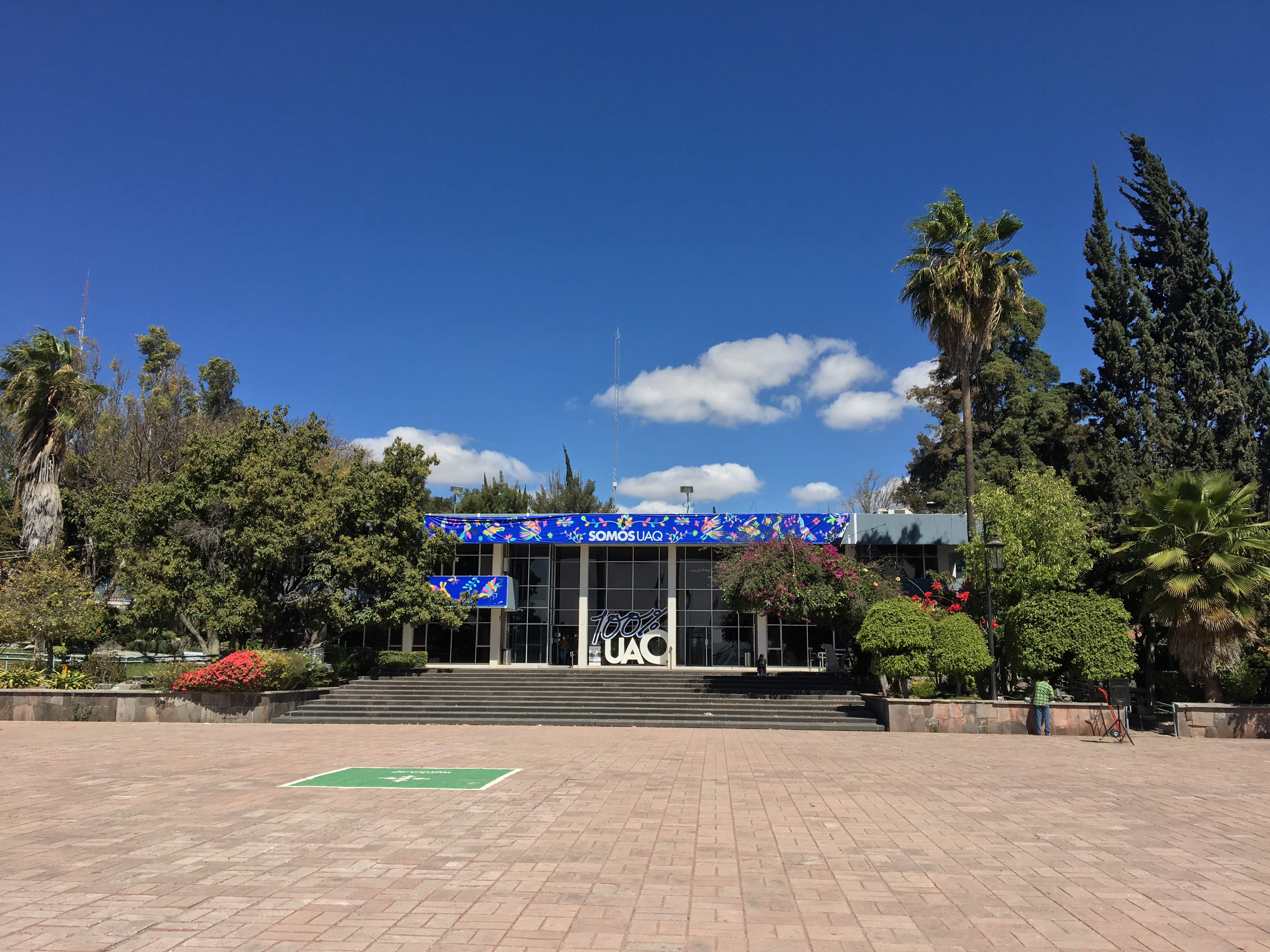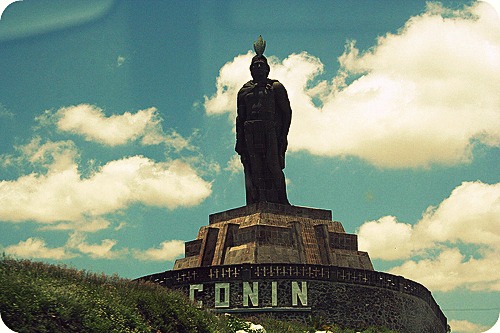|
XHPBQR-TDT
XHPBQR-TDT is a television station on virtual channel 24 (physical channel 11) in Querétaro City, Querétaro, Querétaro. It is the television station of the Universidad Autónoma de Querétaro and transmits from the Sistema Público de Radiodifusión del Estado Mexicano, SPR tower on Cerro El Cimatario. History XHPBQR was awarded to the university in March 2017 and began testing on December 1, with full programming beginning on the 11th of the month. It currently broadcasts from 7am to 12am daily. Programming is planned to include newscasts covering university events, as well as programs produced by the university's academic units, learning and teaching programs. References Television stations in Querétaro, HPBQR-TDT Television channels and stations established in 2017 2017 establishments in Mexico Public television in Mexico Autonomous University of Querétaro {{Mexico-tv-station-stub ... [...More Info...] [...Related Items...] OR: [Wikipedia] [Google] [Baidu] |
Universidad Autónoma De Querétaro
The Autonomous University of Queretaro (in es, Universidad Autónoma de Querétaro, UAQ) is a Mexican public university based in the city of Santiago de Querétaro, Querétaro, but with campuses around the state. The main campus is located in Cerro de las Campanas, but there are campuses in Amealco de Bonfil, Amealco, Amazcala, Cadereyta de Montes, Cadereyta, Corregidora Municipality, Corregidora, Jalpan de Serra, Jalpan, Juriquilla, San Juan del Río, and Tequisquiapan. It is the largest and most important university in both the state and the city of Queretaro. History The University of Queretaro (now the Autonomous University of Queretaro) was founded in 1951 after the closing of the Civil School. Octavio S. Mondragón, then Governor of Querétaro, helped found the university, in the form of a High School, Law School, and Engineering School. In 1952, the School of Chemistry and the School of Nursing were formed. In 1953, the Institute of Fine Arts was formed, and in 1954 the Sc ... [...More Info...] [...Related Items...] OR: [Wikipedia] [Google] [Baidu] |
XHUAQ-FM
XHUAQ-FM is the radio station of the Universidad Autónoma de Querétaro, located in Querétaro, Querétaro. It broadcasts on 89.5 MHz from studios on the UAQ campus and was simulcast on AM station XEUAQ-AM 580 until 2015. History XHUAQ-FM came to air for the first time at 8am on Friday, August 3, 1979. The new station was the first cultural radio station in the state of Querétaro and primarily had musical programming. Cultural programming increased its prevalence in the 1980s, with international programs being bought from such countries as Israel, Germany and the United States; at the same time, more university students and faculty became involved in the station's operations. One of the programs introduced in the 1980s, "Jazzmania", has been on the air since 1983 and is the oldest radio program in the state of Querétaro. The mid-1980s saw the first expansion of the XHUAQ facilities, followed by the 1987 launch of the AM station, which operated with 250 watts of power. The sta ... [...More Info...] [...Related Items...] OR: [Wikipedia] [Google] [Baidu] |
Very High Frequency
Very high frequency (VHF) is the ITU designation for the range of radio frequency electromagnetic waves ( radio waves) from 30 to 300 megahertz (MHz), with corresponding wavelengths of ten meters to one meter. Frequencies immediately below VHF are denoted high frequency (HF), and the next higher frequencies are known as ultra high frequency (UHF). VHF radio waves propagate mainly by line-of-sight, so they are blocked by hills and mountains, although due to refraction they can travel somewhat beyond the visual horizon out to about 160 km (100 miles). Common uses for radio waves in the VHF band are Digital Audio Broadcasting (DAB) and FM radio broadcasting, television broadcasting, two-way land mobile radio systems (emergency, business, private use and military), long range data communication up to several tens of kilometers with radio modems, amateur radio, and marine communications. Air traffic control communications and air navigation systems (e.g. VOR and ILS) wo ... [...More Info...] [...Related Items...] OR: [Wikipedia] [Google] [Baidu] |
Querétaro City
Santiago de Querétaro (; Otomi: Dähnini Maxei), known simply as Querétaro City ( es, Ciudad de Querétaro), is the capital and largest city of the state of Querétaro, located in central Mexico. It is part of the macroregion of Bajío. It is northwest of Mexico City, southeast of San Miguel de Allende and south of San Luis Potosí. It is also the seat of the municipality of Querétaro, divided into seven boroughs. In 1996, the historic center of Querétaro was declared a World Heritage Site by the UNESCO. The city is a strong business and economic center and a vigorous service center that is experiencing an ongoing social and economic revitalization. All this has resulted in high levels of migration from other parts of Mexico. Querétaro has seen outstanding industrial and economic development since the mid-1990s. Querétaro metropolitan area has the 2nd highest GDP per capita among Mexico's metropolitan areas with US$20,000 after Monterrey. The city is the fastest-growing i ... [...More Info...] [...Related Items...] OR: [Wikipedia] [Google] [Baidu] |
Federal Telecommunications Institute
The Federal Telecommunications Institute ( Spanish: ''Instituto Federal de Telecomunicaciones''; abbreviated as IFT and incorrectly referred to as IFETEL) is an independent government agency of Mexico charged with the regulation of telecommunications and broadcasting services. It was formed on September 10, 2013, as part of larger reforms to Mexican telecom regulations, and replaced the Federal Telecommunications Commission (Cofetel). The current President of the IFT is Gabriel Oswaldo Contreras Saldívar. History On August 8, 1996, President Ernesto Zedillo created Cofetel, which originally was based in the tower of the Secretariat of Communications and Transportation. In 2013, President Enrique Peña Nieto created the IFT to replace Cofetel as part of the telecommunications reform package of the Pacto por México. The IFT is an autonomous federal agency that is responsible for the regulation of the use of spectrum, telecommunications and broadcasting networks and offerings, a ... [...More Info...] [...Related Items...] OR: [Wikipedia] [Google] [Baidu] |
Sistema Público De Radiodifusión Del Estado Mexicano
The ''Sistema Público de Radiodifusión del Estado Mexicano'' (Mexican State Public Broadcasting System, abbreviated SPR) until 2014, is an independent Mexican government agency. Its mission is to support the development of public broadcasting in the country and expand its coverage. It carries out this goal through ownership of a nationwide network of transmitters and the management of its own public television channel, Canal Catorce. It also owns four radio transmitters. History By 2010, two major public television stations existed in Mexico: the National Polytechnic Institute's Once TV and Conaculta's Canal 22. The National Autonomous University in Mexico also operated low-powered test broadcaster XHUNAM-TDT channel 20 and the TV UNAM pay-TV network. However, not all of these stations, especially Canal 22 and TV UNAM, had national coverage outside of pay television services. None of them had a general national reach above 30%. The only national public television transmitters o ... [...More Info...] [...Related Items...] OR: [Wikipedia] [Google] [Baidu] |
Television Stations In Querétaro
Television, sometimes shortened to TV, is a telecommunication medium for transmitting moving images and sound. The term can refer to a television set, or the medium of television transmission. Television is a mass medium for advertising, entertainment, news, and sports. Television became available in crude experimental forms in the late 1920s, but only after several years of further development was the new technology marketed to consumers. After World War II, an improved form of black-and-white television broadcasting became popular in the United Kingdom and the United States, and television sets became commonplace in homes, businesses, and institutions. During the 1950s, television was the primary medium for influencing public opinion.Diggs-Brown, Barbara (2011''Strategic Public Relations: Audience Focused Practice''p. 48 In the mid-1960s, color broadcasting was introduced in the U.S. and most other developed countries. The availability of various types of archival stora ... [...More Info...] [...Related Items...] OR: [Wikipedia] [Google] [Baidu] |
Television Channels And Stations Established In 2017
Television, sometimes shortened to TV, is a telecommunication medium for transmitting moving images and sound. The term can refer to a television set, or the medium of television transmission. Television is a mass medium for advertising, entertainment, news, and sports. Television became available in crude experimental forms in the late 1920s, but only after several years of further development was the new technology marketed to consumers. After World War II, an improved form of black-and-white television broadcasting became popular in the United Kingdom and the United States, and television sets became commonplace in homes, businesses, and institutions. During the 1950s, television was the primary medium for influencing public opinion.Diggs-Brown, Barbara (2011''Strategic Public Relations: Audience Focused Practice''p. 48 In the mid-1960s, color broadcasting was introduced in the U.S. and most other developed countries. The availability of various types of archival storag ... [...More Info...] [...Related Items...] OR: [Wikipedia] [Google] [Baidu] |
2017 Establishments In Mexico
Seventeen or 17 may refer to: *17 (number), the natural number following 16 and preceding 18 * one of the years 17 BC, AD 17, 1917, 2017 Literature Magazines * ''Seventeen'' (American magazine), an American magazine * ''Seventeen'' (Japanese magazine), a Japanese magazine Novels * ''Seventeen'' (Tarkington novel), a 1916 novel by Booth Tarkington *''Seventeen'' (''Sebuntiin''), a 1961 novel by Kenzaburō Ōe * ''Seventeen'' (Serafin novel), a 2004 novel by Shan Serafin Stage and screen Film * ''Seventeen'' (1916 film), an American silent comedy film *''Number Seventeen'', a 1932 film directed by Alfred Hitchcock * ''Seventeen'' (1940 film), an American comedy film *''Eric Soya's '17''' (Danish: ''Sytten''), a 1965 Danish comedy film * ''Seventeen'' (1985 film), a documentary film * ''17 Again'' (film), a 2009 film whose working title was ''17'' * ''Seventeen'' (2019 film), a Spanish drama film Television * ''Seventeen'' (TV drama), a 1994 UK dramatic short starring Christien ... [...More Info...] [...Related Items...] OR: [Wikipedia] [Google] [Baidu] |
Public Television In Mexico
In public relations and communication science, publics are groups of individual people, and the public (a.k.a. the general public) is the totality of such groupings. This is a different concept to the sociological concept of the ''Öffentlichkeit'' or public sphere. The concept of a public has also been defined in political science, psychology, marketing, and advertising. In public relations and communication science, it is one of the more ambiguous concepts in the field. Although it has definitions in the theory of the field that have been formulated from the early 20th century onwards, and suffered more recent years from being blurred, as a result of conflation of the idea of a public with the notions of audience, market segment, community, constituency, and stakeholder. Etymology and definitions The name "public" originates with the Latin '' publicus'' (also '' poplicus''), from ''populus'', to the English word 'populace', and in general denotes some mass population ("the p ... [...More Info...] [...Related Items...] OR: [Wikipedia] [Google] [Baidu] |




